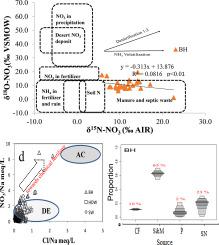Journal of Contaminant Hydrology ( IF 3.5 ) Pub Date : 2020-05-24 , DOI: 10.1016/j.jconhyd.2020.103658 Abass Gibrilla 1 , Joseph R Fianko 2 , Samuel Ganyaglo 1 , Dickson Adomako 2 , Geophrey Anornu 3 , Nafisatu Zakaria 4

|
The rising food production to meet the growing human population has led to increased anthropogenic inputs of nutrients such as NO3− in groundwater and aquatic environments. Nitrate concentrations, hydrochemistry, and isotope data (δ18O-H2O, δ2H–H2O, 15N–NO3, and δ18O–NO3) from boreholes (BH), hand dug wells (HDW), and surface water (SW) were analyzed. The objectives of the study were to identify potential nitrate sources and their proportional contributions using an isotope mixing model (SIAR). The results showed that NO3− concentrations in the BH, HDW, and SW were heterogeneous and controlled by localized anthropogenic activities. The hydrochemistry and dual isotope (15N-NO3 and 18O-NO3) identified manure/sewage as the dominant source of NO3− in the groundwater, while the SW showed a complex signature overlapping in the areas of manure/septic, chemical fertilizer, and soil nitrogen. The SIAR analysis showed that sewage/manure contributed about 66%, 68%, and 55% of NO3− in the BH, HDW, and SW, respectively. In the study area, the NO3− source contribution based on the mean probable estimate (MPE) were in the order S&M > SN > CF > P. Shortcomings and the uncertainties associated with the SIAR to guide future studies have also been discussed. The study also highlighted the use of hydrochemistry, environmental isotopes, and Bayesian isotope mixing models for NO3− source identification and apportionment. This is to enable effective planning, farming practices, and sewage disposals to safeguard groundwater quality and control the eutrophication in rivers to meet safe drinking water demand.
中文翻译:

利用双重同位素(15N和18O-NO3)和贝叶斯同位素混合模型,对加纳地表和地下水中的硝酸盐污染和源解析。
上升的粮食产量,以满足不断增长的人口,导致营养物质,如NO的增加人为投入3 -地下水和水生环境。硝酸盐浓度,水化学,和同位素数据(δ 18 O - H 2 O,δ 2 H-H 2 O,15 N-NO 3,和δ 18 O型NO 3)从钻孔(BH),手挖井(HDW),和地表水(SW)进行了分析。研究的目的是使用同位素混合模型(SIAR)识别潜在的硝酸盐来源及其成比例。结果表明,NO 3 -BH,HDW和SW中的浓度是异质的,并受局部人为活动的控制。水化学和双同位素(15 N-NO 3和18 -O-NO 3)确定粪便/污水作为NO的主要来源3 -在地下水,而SW呈复杂的签名在粪肥/脓毒性的区域重叠,化肥和土壤氮。所述SIAR分析表明,污水/粪肥贡献约66%,68%,和NO的55%3 -在BH,HDW,和SW,分别。在研究领域,NO 3 -基于平均可能估计(MPE)的源贡献按S&M> SN> CF> P的顺序排列。还讨论了缺点和与SIAR相关的不确定性以指导将来的研究。该研究还强调了使用化学,环境同位素,而同位素贝叶斯混合模型NO 3 -源识别和分配。这是为了进行有效的规划,耕作方法和污水处理,以维护地下水质量并控制河流富营养化,从而满足安全的饮用水需求。











































 京公网安备 11010802027423号
京公网安备 11010802027423号